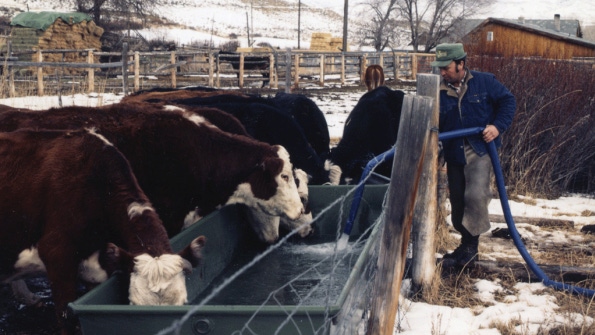Clean water is crucial for cattle in winter months
Cold stress and dehydration can impact cattle health over the winter months.
October 31, 2016

One of the attributes that makes cattle useful is that they can adapt and thrive in many environmental conditions and climates. No matter how well-adapted, though, they need a chance to adjust to seasonal changes.
As temperatures grow colder, for example, cattle grow a longer, thicker hair coat. This, and a layer of fat under the hide, provides insulation to reduce heat loss and minimize cold stress. Changing temperatures in the fall combined with shorter days and longer nights stimulate appetite, growth of winter hair and other physiological changes.
As days get shorter and colder, feed intake increases, and passage of feed through the gut speeds up as cattle need more fuel to keep warm. Feed requirements may go up 10% to 25%. These changes increase heat production and help the animal withstand winter temperatures.
To process that additional feed, the digestive tract needs adequate fluid. That’s why it is important to provide adequate water during cold weather. A cow’s water requirements are not as high in winter, however, as in summer, when she’s losing water in various ways to dissipate body heat, but she must drink enough to handle the demands of ruminant digestion and increased metabolism to prevent dehydration and impaction.
“In winter, we often don’t think about water requirements for cattle, but the body’s demand for water is important whether it’s hot or cold,” says Terry Mader, Mader Consulting, Gretna, Neb., and professor emeritus, University of Nebraska-Lincoln. “This can be a challenge, however, when temperatures drop well below freezing, or water supplies are diminished due to lack of rainfall,” he says.

Winter is always challenging for cattle. Not only do they have to battle the cold and rustle enough groceries for both themselves and their growing fetuses, but they also have to find enough water to keep their digestive systems working properly.
“We don’t always get ice broken or have sufficient open water. In cold or wet conditions, if cattle can get out of the wind, they don’t always move out of sheltered areas to go to water. Sometimes they only go to water every second or third day,” says Mader.
“Ruminants have a large storage reservoir to draw on, but it’s not ideal to go that long without water; it’s difficult to maintain normal metabolic function if they have to continually draw on that reservoir and deplete tissue stores. Regarding diet and the amount of water in the rumen — and how much of it can be absorbed and still maintain normal function — there is still a lot we don’t know,” he says.
Vital nutrient
What we do know, however, is that water is one of the most important nutrients; animals can’t live very long without it. Pregnant animals need plenty of water available for the fetus, and lactating animals require additional water for milk production.
“We don’t know how much we can restrict water and have cattle remain healthy, but unlimited access to clean water is best. Our work with heat stress shows that even in hot weather, animals don’t like to drink really cold water. They prefer it about 60 to 70 degrees [F]. In winter, if water is close to freezing, some cattle may not drink an optimum amount,” he says.
In hot conditions, cattle dehydrate quickly. “They need access to water every six hours, particularly in a feedlot. In winter, they may go 24 to 48 hours without water. Physiological status won’t be ideal if they go 24 hours without water, but they continue to function. By 48 hours, it becomes more problematic,” says Mader.
“In extreme conditions, experiencing stress, cattle don’t always have a sense of thirst [whether it’s heat stress or cold stress] due to overriding factors. The animals’ priority is to deal with the stress and survive. Depending on stress level, cattle may not be consuming enough water,” he says.
“There is also a tendency to urinate more with stresses such as shipping, handling, moving or severe cold stress, depleting the body’s water reserves,” he adds. Cold stress may increase metabolic use of water, and cattle urinate more because the body is getting rid of anything extra that must be kept warm. If cattle are not drinking enough, they dehydrate.

“We don’t know how much we can restrict water and have cattle remain healthy, but unlimited access to clean water is best.†Terry Mader
“There is a definite relationship between feed intake and water intake unless they are consuming a high-moisture feed,” says Mader. But high-moisture feed for pasture cattle doesn’t mix well with severely cold weather; it’s difficult for cattle to eat a high-moisture feed because it will freeze.
“Any animal with health issues or running a fever is experiencing stress that can override thirst, which can result in inadequate body fluids. You don’t always see subclinical issues, so it becomes extremely important that cattle have good access to clean water at all times,” Mader says. Providing water is also important from an animal welfare standpoint and is good animal husbandry.
Cattle need ample water for normal rumen function, good feed mixing in the rumen and to maintain normal gut motility. “I’ve seen cattle on dry feed with inadequate water that become constipated, with very firm manure. Microbes in the rumen need a fluid environment to function best,” Mader says. Rumen microbes need adequate protein and moisture for optimum fermentation.
Pass the salt
“Water is also important to maintain good electrolyte balances in the body. Every process in the body is driven by the ability to move nutrients across cell walls. The body is mostly water. Good cellular health, gut function, nutrient utilization, normal metabolic function [and keeping the body at proper temperature] all depend on adequate supplies of water,” Mader says.
Adequate salt is also essential; sodium and chloride are important electrolytes.
Trey Patterson, general manager of the Padlock Ranch, Ranchester, Wyo., has seen situations where producers were supplementing cows, and the supplement contained no salt. “If cattle don’t have salt, water intake goes down and then feed intake goes down. Some of those cows will be gaunt and, over an extended period, become emaciated,” he says.
That’s why you need proper balance with a certain sodium level in the forage. Cattle need all of these things together: feed, salt and water. You can’t have that balance upset too much or something will suffer.

Breathtaking photos of winter on the ranch
The first snow hit parts of the Midwest this week. Mentally prepare for the winter wonderland with these stunning photos. See photos here.
We generally think of dehydration and electrolyte loss only occurring during hot weather and heat stress due to water loss via sweating, panting, etc., according to Greg Hermesmeyer, TechMix LLC. “Dehydration can also occur in cold weather, and as cattle become dehydrated they are losing key elements: sodium, potassium and chloride.”
Those electrolytes are crucial to the body, especially at the cellular level, for proper metabolic and biological function (such as carrying nutrients in and out of the cells), muscle function and other basic physiological functions, he says. “We want to make sure we replace these and keep good electrolyte balance.”
Cattle that are shivering to stay warm also use energy, depleting reserves of energy and water. “At the cellular level, when cattle lose electrolytes, there is major loss of sodium and potassium. Then the cells are unable to function properly. Cattle need important elements replaced to restore proper cellular metabolism and function,” Hermesmeyer says.
Let’s be safe out there
When cattle are in big pastures, you need to monitor them and know what’s happening. “We are adamant about having water available to cattle all the time,” Patterson says. This may mean breaking ice, tank heaters, frost-free tanks, moving water — whatever it takes.
One time-honored way of providing winter water is chopping ice. However, chopping ice at the edge of a reservoir, pond or small stream can be difficult when ice gets thick and water levels change.
“Ice may go clear down into the mud. Make sure you are getting through it into adequate water, so cattle can get a drink that’s out of the mud,” Patterson emphasizes. If this happens, the water has receded and you are working farther out — and cattle have to walk on ice to get to the water.
“When we’re concerned about cattle getting out on the ice, we put an electric fence across the corner of the pond or reservoir. We drive a post on one side, pull the wire across a corner and drive a post on the other side, fence off the rest of the reservoir and put a charger on the fence,” he says.
This way, cattle only have access to the 10 or 15 feet that allows you to get the ice away from the mud, with access to water. “You can always move the fence if you need to, but it keeps cattle from getting farther out where they might fall through,” Patterson explains.
Heather Smith Thomas is a rancher and freelance writer based in Salmon, Idaho.
You might also like:
Holmes and Fletcher classic cartoons
4 tips for grazing corn stalks this fall
What's the big deal about fetal programming?
Stunning fall snapshots from the ranch
HSUS is a fox in the hen house
You May Also Like


.png?width=300&auto=webp&quality=80&disable=upscale)
